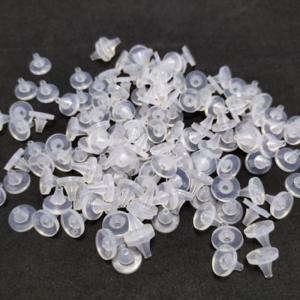Durable Silicone Rubber Kitchen Tap Seals from Chinese Manufacturer
Characteristics:
| Basic Information | |
| Materials | Silicone |
| Features | Good Sealing, Water and Chloramine Resistance, High and Low Temperature Resistance, Ageing Resistance |
| Application | Bathroom Shower Head |
| Production Method | Rubber Compression Mold and LSR Injection Mold |
| Production Standard | According to ASTM, DIN, JIS standard |
| Certification | WRAS, NSF, FDA, SGS etc |
| Hardness (Durometer) | 30-95 Shore A (+/- 5 Shore A) |
| Temperature | -40°C to 230°C |
| Color | Custom |
Optimizing Silicone Shower Nozzle Production:
To streamline production and ensure quality, many manufacturers employ mold steel milling techniques for forming needles used in silicone shower head nozzle production. While initially challenging to detect during testing, burrs in the silicone nozzles can significantly compromise quality during mass production as mold tool wear increases over time. By incorporating needles and multiple mold plates, including wire cutting for needle installation, this approach enables precise control over burr formation, ensuring consistent nozzle quality while reducing production time and maintenance costs.
Customized OEM/ODM Solutions: Fast Quotation Requests:
- Provide 2D/3D Design Drawings
- Specify Design and Size Requirements

- Define Hardness Standards
- Set Hardness Tolerance Specifications
- Clarify Material Preferences
- Outline Production Environment Requirements
- Specify Certification Needs (ASTM, DIN, JIS, ISO, SGS, etc.)
- Detail Production Environment Preferences
Shower Head Nozzle Impact on Water Flow:
- Nozzle Design: The size and shape of shower head nozzles affect water flow. Round holes typically offer better spray performance due to their streamlined flow pattern.
- Nozzle Structures: Shower head nozzles come in various designs, such as extended cylinder and inserted cylinder types. Compared to extended cylinder nozzles, inserted cylinder ones experience more flow disturbance, resulting in slower flow rates.
- Flow Dynamics: Nozzle flow speed is influenced by the relative sizes of outlet and inlet areas. Nozzles with smaller outlets have slower flows, while those with larger outlets have faster flows. Streamline nozzles may not achieve maximum flow capacity.
Manufacturing Process of Rubber Kitchen Tap Seals
1. Raw Material Preparation
Raw rubber materials are sourced and prepared according to specific formulations designed for durability and flexibility in kitchen tap seals.
2. Mixing and Compounding
The raw rubber materials undergo mixing and compounding processes. This involves blending the rubber with additives such as vulcanizing agents and plasticizers to achieve desired properties like strength and resilience.
3. Molding
The rubber compound is then shaped into the desired form using compression or injection molding techniques. Molds are carefully designed to create precise shapes and dimensions that fit various types of kitchen tap configurations.
![]()
4. Vulcanization
The molded rubber components undergo vulcanization, a curing process where heat and pressure are applied. This step cross-links the rubber molecules, enhancing durability and resistance to heat and water.
5. Finishing and Quality Control
After vulcanization, the seals undergo finishing processes such as trimming excess material and inspecting for defects. Quality control measures ensure each seal meets rigorous standards for functionality and performance.
6. Packaging
Finished rubber kitchen tap seals are carefully packaged to protect against damage during storage and transportation. Packaging may include labeling with product information and instructions for installation.
![]()
Advantages of the Manufacturing Process
The use of compression or injection molding ensures precise shaping and uniformity in each rubber seal, guaranteeing a snug fit and effective sealing for kitchen taps. Vulcanization enhances the seals’ resilience, making them resistant to wear, tear, and environmental factors in kitchen settings.